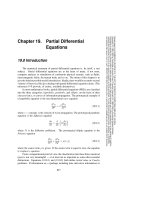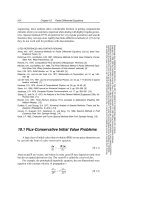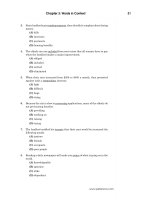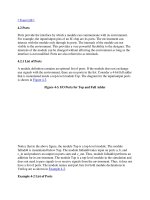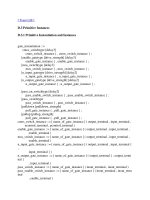Tài liệu Partial Differential Equations part 5 ppt
Bạn đang xem bản rút gọn của tài liệu. Xem và tải ngay bản đầy đủ của tài liệu tại đây (109.18 KB, 7 trang )
19.4 Fourier and Cyclic Reduction Methods
857
Sample page from NUMERICAL RECIPES IN C: THE ART OF SCIENTIFIC COMPUTING (ISBN 0-521-43108-5)
Copyright (C) 1988-1992 by Cambridge University Press.Programs Copyright (C) 1988-1992 by Numerical Recipes Software.
Permission is granted for internet users to make one paper copy for their own personal use. Further reproduction, or any copying of machine-
readable files (including this one) to any servercomputer, is strictly prohibited. To order Numerical Recipes books,diskettes, or CDROMs
visit website or call 1-800-872-7423 (North America only),or send email to (outside North America).
For example, a combined advective-diffusion equation, such as
∂u
∂t
= −v
∂u
∂x
+ D
∂
2
u
∂x
2
(19.3.21)
might profitably use an explicit scheme for the advective term combined with a
Crank-Nicholson or other implicit scheme for the diffusion term.
The alternating-direction implicit (ADI) method, equation (19.3.16), is an
example of operator splitting with a slightly different twist. Let us reinterpret
(19.3.19) to have a different meaning: Let U
1
now denote an updating method that
includes algebraically all the pieces of the total operator L, but which is desirably
stable only for the L
1
piece; likewise U
2
,...U
m
. Then a method of getting from
u
n
to u
n+1
is
u
n+1/m
= U
1
(u
n
, ∆t/m)
u
n+2/m
= U
2
(u
n+1/m
, ∆t/m)
···
u
n+1
= U
m
(u
n+(m−1)/m
, ∆t/m)
(19.3.22)
The timestep for each fractional step in (19.3.22) is now only 1/mofthefulltimestep,
because each partial operation acts with all the terms of the original operator.
Equation(19.3.22) is usually, though notalways, stable asa differencingscheme
for the operator L. In fact, as a rule of thumb, it is often sufficient to have stable U
i
’s
only for the operator pieces having the highest number of spatial derivatives — the
other U
i
’s can be unstable — to make the overall scheme stable!
It is at this point that we turn our attention from initial value problems to
boundary value problems. These will occupy us for the remainder of the chapter.
CITED REFERENCES AND FURTHER READING:
Ames, W.F. 1977,
Numerical Methods for Partial Differential Equations
, 2nd ed. (New York:
Academic Press).
19.4 Fourier and Cyclic Reduction Methods for
Boundary Value Problems
As discussed in §19.0, most boundary value problems (elliptic equations, for
example) reduce to solving large sparse linear systems of the form
A · u = b (19.4.1)
either once, for boundary value equations that are linear, or iteratively, for boundary
value equations that are nonlinear.
858
Chapter 19. Partial Differential Equations
Sample page from NUMERICAL RECIPES IN C: THE ART OF SCIENTIFIC COMPUTING (ISBN 0-521-43108-5)
Copyright (C) 1988-1992 by Cambridge University Press.Programs Copyright (C) 1988-1992 by Numerical Recipes Software.
Permission is granted for internet users to make one paper copy for their own personal use. Further reproduction, or any copying of machine-
readable files (including this one) to any servercomputer, is strictly prohibited. To order Numerical Recipes books,diskettes, or CDROMs
visit website or call 1-800-872-7423 (North America only),or send email to (outside North America).
Two important techniques lead to “rapid” solution of equation (19.4.1) when
the sparse matrix is of certain frequently occurring forms. The Fourier transform
method is directly applicable when the equations have coefficients that are constant
in space. The cyclic reduction method is somewhat more general; its applicability
is related to the question of whether the equations are separable (in the sense of
“separation of variables”). Both methods require the boundaries to coincide with
the coordinate lines. Finally, for some problems, there is a powerful combination
of these two methods called FACR (Fourier Analysis and Cyclic Reduction).We
now consider each method in turn, using equation (19.0.3), with finite-difference
representation (19.0.6), as a model example. Generally speaking, the methods in this
section are faster, when they apply, than the simpler relaxation methods discussed
in §19.5; but they are not necessarily faster than the more complicated multigrid
methods discussed in §19.6.
Fourier Transform Method
The discrete inverse Fourier transform in both x and y is
u
jl
=
1
JL
J−1
m=0
L−1
n=0
u
mn
e
−2πijm/J
e
−2πiln/L
(19.4.2)
This can be computed using the FFT independently in each dimension, or else all at
once via the routine fourn of §12.4 or the routine rlft3 of §12.5. Similarly,
ρ
jl
=
1
JL
J−1
m=0
L−1
n=0
ρ
mn
e
−2πijm/J
e
−2πiln/L
(19.4.3)
If we substitute expressions (19.4.2) and (19.4.3) in our model problem (19.0.6),
we find
u
mn
e
2πim/J
+ e
−2πim/J
+ e
2πin/L
+ e
−2πin/L
− 4
=ρ
mn
∆
2
(19.4.4)
or
u
mn
=
ρ
mn
∆
2
2
cos
2πm
J
+cos
2πn
L
− 2
(19.4.5)
Thus the strategy for solving equation (19.0.6) by FFT techniques is:
• Computeρ
mn
as the Fourier transform
ρ
mn
=
J −1
j=0
L−1
l=0
ρ
jl
e
2πimj/J
e
2πinl/L
(19.4.6)
• Computeu
mn
from equation (19.4.5).
19.4 Fourier and Cyclic Reduction Methods
859
Sample page from NUMERICAL RECIPES IN C: THE ART OF SCIENTIFIC COMPUTING (ISBN 0-521-43108-5)
Copyright (C) 1988-1992 by Cambridge University Press.Programs Copyright (C) 1988-1992 by Numerical Recipes Software.
Permission is granted for internet users to make one paper copy for their own personal use. Further reproduction, or any copying of machine-
readable files (including this one) to any servercomputer, is strictly prohibited. To order Numerical Recipes books,diskettes, or CDROMs
visit website or call 1-800-872-7423 (North America only),or send email to (outside North America).
• Compute u
jl
by the inverse Fourier transform (19.4.2).
The above procedure is valid for periodic boundary conditions. In other words,
the solution satisfies
u
jl
= u
j+J,l
= u
j,l+L
(19.4.7)
Nextconsidera Dirichlet boundary conditionu =0on therectangularboundary.
Instead of the expansion (19.4.2), we now need an expansion in sine waves:
u
jl
=
2
J
2
L
J−1
m=1
L−1
n=1
u
mn
sin
πjm
J
sin
πln
L
(19.4.8)
This satisfies the boundary conditions that u =0at j =0,J and at l =0,L.Ifwe
substitute this expansion and the analogous one for ρ
jl
into equation (19.0.6), we
find that the solution procedure parallels that for periodic boundary conditions:
• Computeρ
mn
by the sine transform
ρ
mn
=
J −1
j=1
L−1
l=1
ρ
jl
sin
πjm
J
sin
πln
L
(19.4.9)
(A fast sine transform algorithm was given in §12.3.)
• Computeu
mn
from the expression analogous to (19.4.5),
u
mn
=
∆
2
ρ
mn
2
cos
πm
J
+cos
πn
L
− 2
(19.4.10)
• Compute u
jl
by the inverse sine transform (19.4.8).
If we have inhomogeneous boundary conditions, for example u =0on all
boundaries except u = f(y) on the boundary x = J∆, we have to add to the above
solution a solution u
H
of the homogeneous equation
∂
2
u
∂x
2
+
∂
2
u
∂y
2
=0 (19.4.11)
that satisfies the required boundary conditions. In the continuum case, this would
be an expression of the form
u
H
=
n
A
n
sinh
nπx
J∆
sin
nπy
L∆
(19.4.12)
where A
n
would be found by requiring that u = f(y) at x = J∆. In the discrete
case, we have
u
H
jl
=
2
L
L−1
n=1
A
n
sinh
πnj
J
sin
πnl
L
(19.4.13)
860
Chapter 19. Partial Differential Equations
Sample page from NUMERICAL RECIPES IN C: THE ART OF SCIENTIFIC COMPUTING (ISBN 0-521-43108-5)
Copyright (C) 1988-1992 by Cambridge University Press.Programs Copyright (C) 1988-1992 by Numerical Recipes Software.
Permission is granted for internet users to make one paper copy for their own personal use. Further reproduction, or any copying of machine-
readable files (including this one) to any servercomputer, is strictly prohibited. To order Numerical Recipes books,diskettes, or CDROMs
visit website or call 1-800-872-7423 (North America only),or send email to (outside North America).
If f(y = l∆) ≡ f
l
,thenwegetA
n
from the inverse formula
A
n
=
1
sinh πn
L−1
l=1
f
l
sin
πnl
L
(19.4.14)
The complete solution to the problem is
u = u
jl
+ u
H
jl
(19.4.15)
By adding appropriate terms of the form (19.4.12), we can handle inhomogeneous
terms on any boundary surface.
A much simpler procedure for handling inhomogeneous terms is to note that
whenever boundary terms appear on the left-hand side of (19.0.6), they can be taken
over to the right-hand side since they are known. The effective source term is
therefore ρ
jl
plus a contribution from the boundary terms. To implement this idea
formally, write the solution as
u = u
+ u
B
(19.4.16)
where u
=0on the boundary, while u
B
vanishes everywhere except on the
boundary. There it takes on the given boundary value. In the above example, the
only nonzero values of u
B
would be
u
B
J,l
= f
l
(19.4.17)
The model equation (19.0.3) becomes
∇
2
u
= −∇
2
u
B
+ ρ (19.4.18)
or, in finite-difference form,
u
j+1,l
+ u
j−1,l
+ u
j,l+1
+ u
j,l−1
− 4u
j,l
=
− (u
B
j+1,l
+ u
B
j−1,l
+ u
B
j,l+1
+ u
B
j,l−1
− 4u
B
j,l
)+∆
2
ρ
j,l
(19.4.19)
All the u
B
terms in equation (19.4.19) vanish except when the equation is evaluated
at j = J − 1,where
u
J,l
+ u
J −2,l
+ u
J −1,l+1
+ u
J −1,l−1
− 4u
J −1,l
= −f
l
+∆
2
ρ
J−1,l
(19.4.20)
Thus the problem is now equivalent to the case of zero boundary conditions, except
that one row of the source term is modified by the replacement
∆
2
ρ
J −1,l
→ ∆
2
ρ
J −1,l
− f
l
(19.4.21)
The case of Neumann boundary conditions ∇u =0is handled by the cosine
expansion (12.3.17):
u
jl
=
2
J
2
L
J
m=0
L
n=0
u
mn
cos
πjm
J
cos
πln
L
(19.4.22)
19.4 Fourier and Cyclic Reduction Methods
861
Sample page from NUMERICAL RECIPES IN C: THE ART OF SCIENTIFIC COMPUTING (ISBN 0-521-43108-5)
Copyright (C) 1988-1992 by Cambridge University Press.Programs Copyright (C) 1988-1992 by Numerical Recipes Software.
Permission is granted for internet users to make one paper copy for their own personal use. Further reproduction, or any copying of machine-
readable files (including this one) to any servercomputer, is strictly prohibited. To order Numerical Recipes books,diskettes, or CDROMs
visit website or call 1-800-872-7423 (North America only),or send email to (outside North America).
Here the double prime notation means that the terms for m =0and m = J should
be multiplied by
1
2
, and similarly for n =0and n = L. Inhomogeneous terms
∇u = g can be again included by adding a suitable solution of the homogeneous
equation, or more simply by taking boundary terms over to the right-hand side.
For example, the condition
∂u
∂x
= g(y) at x =0 (19.4.23)
becomes
u
1,l
− u
−1,l
2∆
= g
l
(19.4.24)
where g
l
≡ g(y = l∆). Once again we write the solution in the form (19.4.16),
where now ∇u
=0on the boundary. This time ∇u
B
takes on the prescribed value
on the boundary, but u
B
vanishes everywhere except just outside the boundary.
Thus equation (19.4.24) gives
u
B
−1,l
= −2∆g
l
(19.4.25)
All the u
B
terms in equation (19.4.19) vanish except when j =0:
u
1,l
+ u
−1,l
+ u
0,l+1
+ u
0,l−1
− 4u
0,l
=2∆g
l
+∆
2
ρ
0,l
(19.4.26)
Thus u
is the solution of a zero-gradient problem, with the source term modified
by the replacement
∆
2
ρ
0,l
→ ∆
2
ρ
0,l
+2∆g
l
(19.4.27)
Sometimes Neumann boundary conditions are handled by using a staggered
grid, with the u’s defined midway between zone boundaries so that first derivatives
are centered on the mesh points. You can solve such problems using similar
techniques to those described above if you use the alternative form of the cosine
transform, equation (12.3.23).
Cyclic Reduction
Evidently the FFT method works only when the original PDE has constant
coefficients, and boundaries that coincide with the coordinate lines. An alternative
algorithm, which can be used on somewhat more general equations, is called cyclic
reduction (CR).
We illustrate cyclic reduction on the equation
∂
2
u
∂x
2
+
∂
2
u
∂y
2
+ b(y)
∂u
∂y
+ c(y)u = g(x, y)(19.4.28)
This form arises very often in practice from the Helmholtz or Poisson equations in
polar, cylindrical,or spherical coordinate systems. More general separable equations
are treated in
[1]
.
